The following is a report by Carlos Martinez on a delegation to China, organised by the CPC’s International Department, that Friends of Socialist China was invited to join. Carlos’s report describes the intensive program of activities that the delegation participated in, as well as detailing some of the discussions and observations on China’s path to modernisation, common prosperity, whole process people’s democracy, rights of migrant workers, and the nature and trajectory of Chinese socialism.
The Third Communist Party Leaders Delegation of North American, Oceanian and Nordic Countries visited China from 24 June to 4 July, at the invitation of the International Department of the Central Committee of the Communist Party of China (IDCPC).
Friends of Socialist China were invited to join this delegation, along with the Communist Party of Australia, the Communist Party of Britain, the Communist Party of Ireland, the Communist Party of Finland, the Communist Party (Sweden), the Communist Party of Norway, the Communist Party USA, the Communist Party of Canada (including Le Parti communiste du Québec), the Communist Party of Denmark, the New Communist Party of Britain, and the Communist Party of Great Britain (Marxist-Leninist). We were represented by co-editors Keith Bennett and Carlos Martinez and advisory group member Francisco Domínguez.
The intensive and incredibly well-organised program included meetings with academics, ‘red tourism’, visits to communities and enterprises, cultural activities, and discussions with the IDCPC, the Communist Youth League of China, the All-China Federation of Trade Unions and the Party School of the CPC Central Committee.
The first destination was Guangzhou (capital city of Guangdong Province in southern China), and the first activity was a presentation and Q&A session at the Guangdong Academy of Social Sciences, introduced by its President, Wang Tinghui, and led by Professor Deng Zhiping.
Deng Zhiping gave an overview of China’s approach to modernisation – characterised by common prosperity for all, harmony between humanity and nature, material and cultural-ethical advancement, and peaceful development – and described the leading role played by Guangdong in this process. Historically Guangdong has always been an area associated with trade; indeed it was the starting point of the Maritime Silk Road, connecting China, South and Southeast Asia, Arabia, East Africa and Europe. In the recent era, Reform and opening up started with the establishment of four Special Economic Zones (SEZs), three of which were in Guangdong Province. Today Guangdong’s GDP ranks alongside Italy and Türkiye, and surpassed South Korea in 2021. Its per capita GDP now exceeds 15,000 USD, indicating that it has been able to jump out of the ‘middle-income trap’.
Guangdong’s average life expectancy is now 79.3, and all the province’s social and economic indicators are steadily improving. Enrolment rate in higher education is 58 percent, up from 28 percent in 2010. More than 158 million residents are covered by social security, and inequality is trending downwards. With the focus on rural regeneration, the urban-rural income ratio has narrowed from 2.7 a decade ago to 2.4 today.
Guangzhou has long been a trailblazer in green development, and in recent years there has been a strong emphasis on building a “green and beautiful Guangdong” – pursuing high-quality development which is green and open, based on innovation and sharing. Professor Deng emphasised that “the colour of our further modernisation is green”. Economic activity in the province is increasingly oriented towards renewable energy and electric vehicles, and major efforts are underway to improve public transport and protect biodiversity.
In response to a question about the living standards of migrant workers, Professor Deng pointed out that Guangdong is currently home to around 26 million such workers. The government is actively working on multiple fronts to enhance their rights and living conditions, including by improving the minimum wage; encouraging union membership and collective bargaining; strictly enforcing labour laws; guaranteeing equal access to social services (including medical care and children’s education); and lowering the threshold for migrant workers to gain household registration (hukou) in their cities of residence.
Following the visit to Guangdong Academy of Social Sciences, we were taken to visit the headquarters of two companies, KingMed Diagnostics Group and the Guangzhou Automobile Group (GAC). KingMed is a pioneer in medical testing, and is at the forefront of advanced cancer diagnostics. Particularly interesting from a political point of view was the relationship between the company and the CPC: while KingMed is a private company, it has a large and active CPC branch which works to protect workers’ rights and coordinate with company management to ensure that corporate strategy complements the country’s overall development goals and serves the people. This concrete example gave the delegates a deeper understanding of the dynamics of the socialist market economy and how China is leveraging capital towards an overall socialist project.
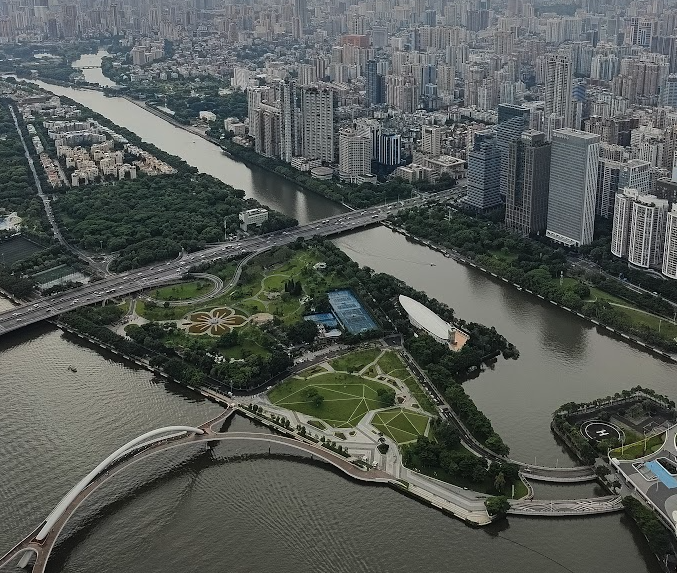
At GAC, China’s leading car manufacturer, we learned about how this state-owned enterprise is working at the cutting edge of electric vehicle development.
Walking around Guangzhou – a megacity of 18 million residents, in a province whose urbanisation rate has increased from 16 to 75 percent in the last four decades – it is striking how clean, green and well-organised it is. There are no slums, there is no homelessness. Trees line every road, and there are ample parks and green spaces, along with huge numbers of low-cost apartment blocks. In that sense, China’s cities stand in stark contrast to the megacities elsewhere in the developing world, which are so often characterised by intense poverty, squalor and homelessness.
We only spent 36 hours in Guangzhou before travelling to Guiyang, capital city of Guizhou province, where we stayed for four days at the CPC’s Guizhou Provincial Party School. The school was founded in 1950 and provides education on Marxist theory, leadership skills, organisational skills and community building. The school’s facilities are extensive and impressive – it can currently accommodate up to 2,000 students at any given time.
At the Guizhou school, the delegation participated in a study session led by Professor Qui Zhonghui on the modernisation of the primary-level governance system and the CPC’s objective of improving grassroots governance, as part of a broader project of building whole-process people’s democracy.
Qui Zhonghui noted that, at the CPC’s 19th Congress in 2017, it was agreed that the principal contradiction faced by Chinese society in the current era had become that between the people’s ever-growing needs for a better life and unbalanced and inadequate development. The theory and practice of governance therefore aims to help resolve that contradiction and to develop “an open governance system with the participation of all people.”
Governance responsibilities at the village and neighbourhood level are wide-ranging, and include the promotion of social vitality (encouraging mutual aid, trust, connection and cooperation), developing a greater sense of community, understanding and solving problems, as well as helping to maintain social harmony and security.
Professor Qui talked about a local community on the outskirts of Guiyang, called Jinyuan, which had been established in 2013 as a test case for various initiatives in grassroots governance and participatory democracy. Alongside 19 full-time workers, there are also eight teams of volunteers (mainly CPC members) that help deal with residents’ problems, organise activity groups for children and older people, and generally look out for people. During the pandemic, these teams would also prioritise helping those older people in the community who live alone.
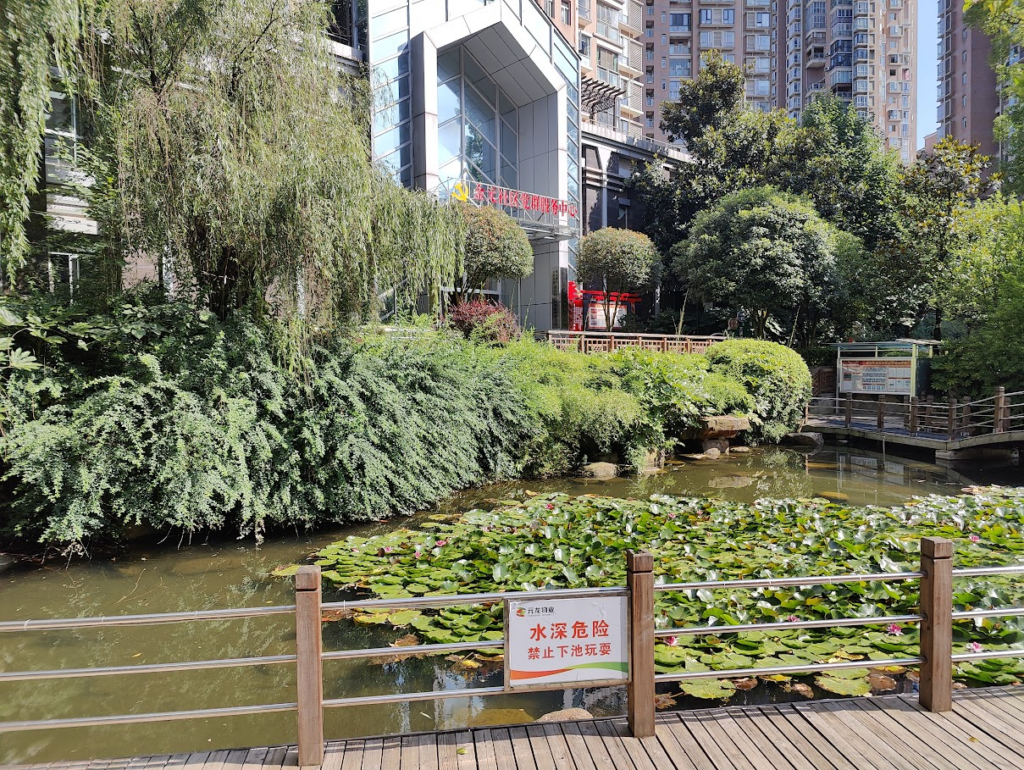
We had the opportunity to visit Jinyuan community later the same day, and were given a guided tour by the community leader, a young woman who was also a delegate to the CPC’s 20th Congress in October 2022. She proudly showed us the community’s buildings and facilities, which include several smart and well-maintained apartment blocks (housing a total of around 10,000 people), a library, an activity room, lots of green space, and plenty of communal areas. She said that the community’s employees and volunteers pride themselves on being available and responsive, and that “whenever residents have a need, we try to solve it.” There are QR codes at several points in the common areas so that residents can easily contact community workers. Going past the activity room, we saw a dance group in action; there are also groups for tai chi, music, painting and discussion. It certainly gave the impression of being a vibrant community and a good place to live.
While in Guizhou, we spent a day in the city of Zunyi, a prefecture-level city of some 6.6 million people in the north of the province. The day started with some ‘red tourism’, visiting the site of the 1935 Zunyi Conference – a crucial episode in the history of the Chinese Revolution and of China’s adaptation and evolution of Marxism. The site is beautifully preserved and the connected Zunyi Conference Memorial Museum is outstanding. It was impressive to see how seriously China takes its revolutionary history and how much effort is put into preserving it and making it accessible.
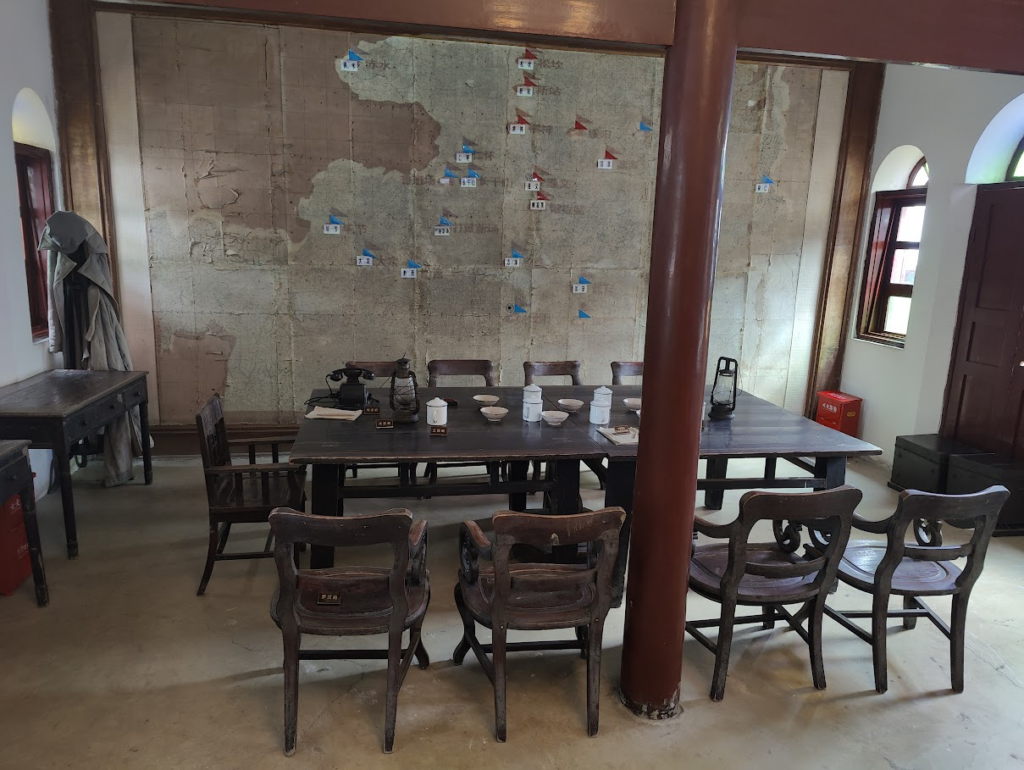
While in Zunyi we also visited the Zunyi Municipal Committee Party School, where we were given a presentation on the CPC’s history by Yang Heying, deputy dean of the school’s Department of Marxism. Professor Yang explained the significance of the Zunyi Conference as a life-or-death turning point in the history of the Chinese Revolution. Rectifying the recent mistakes, which had seen the party’s membership go from 300,000 to 40,000 as a result of the Kuomintang’s fifth extermination campaign waged against the Jiangxi Soviet, the Zunyi Conference set the stage for the party to independently solve the problems of the Revolution, and established a consensus around Mao Zedong’s leadership and theoretical adaptation of Marxism to China’s situation: basing the revolution in the countryside, encircling the cities, and ultimately seizing nationwide power by armed force.
Professor Yang gave an overview history of the party, describing four distinct but closely-related periods: 1) the period of the National Democratic Revolution, starting with the founding of the CPC in 1921 and ending with the establishment of the People’s Republic of China in 1949; 2) the period of revolution and initial socialist construction, from 1949 to 1978; 3) the period of Reform and Opening Up and initial socialist modernisation, from 1978 to 2012; and 4) the New Era of Reform and Opening Up and socialist modernisation.
While Westerners often emphasise the differences between the periods of the Chinese Revolution – in particular the shift that took place with the start of Reform and Opening Up in 1978 – Yang Heying focused on the essential continuities, noting that the CPC considers each period to have provided the crucial foundations for the next. For example, while dismissed by bourgeois economists as a failure, the large-scale socialist construction that took place between 1956 and 1976 was the period of “the most profound and extensive changes in Chinese history”, during which basic industry was built, GDP increased four-fold, China’s UN seat was restored, and diplomatic relations established with 125 countries.
The Reform and Opening Up period, dismissed by some on the left as a capitulation to capitalism, witnessed a massive increase in productivity, and an average GDP growth rate of nearly 10 percent – three times the global average. Living standards improved accordingly: during this period, the problem of feeding and clothing the entire population was essentially solved.
The New Era of Socialism with Chinese Characteristics, starting with the CPC’s 18th Congress in 2012, aims to build a modern socialism which is “strong, democratic, civilised, harmonious, and beautiful”, with a focus on people-centred development, common prosperity, and harmony between humans and nature.
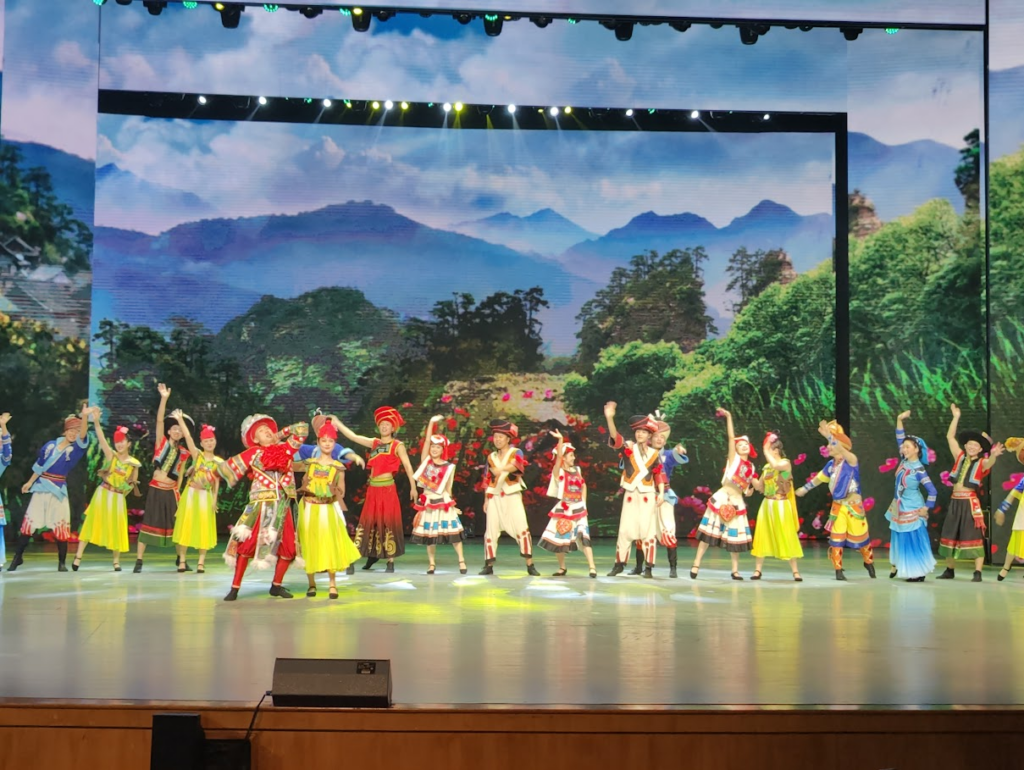
An unexpected highlight of our visit to Guizhou was an evening spent at the Guiyang Grand Theatre, where our delegation watched an amazing variety show largely showcasing music and dance from the province’s ethnic minorities. The themes of the performances varied from love songs to folk stories to re-enactments of sections of the Long March. The theatre was packed with locals, and it was obvious that there are ample facilities and resources for people to participate in and enjoy cultural activities at all levels. On a related note, we also drove past an outdoor basketball match between two local teams, which had a large and enthusiastic crowd of spectators. This reflects a concerted effort by the government to encourage participation in sports for all.
In Guizhou we also visited the beautifully-preserved ancient town of Qingyan. This town boasts multiple Buddhist and Daoist temples, as well as a Protestant church and a Catholic house of worship. Contrary to the constant disinformation put about in the Western media, China celebrates both its ancient culture and its religious and ethnic diversity.

In Beijing, we had friendly and interesting exchanges with Zhou Rongguo, Director General of the IDCPC’s Bureau for North American, Oceanian and Nordic Affairs; Guo Yezhou, Vice Minister of the IDCPC; Shapkat Wushur, member of the Secretariat of the Communist Youth League of China Central Committee; and Xiong Xuanguo, Deputy Chair of the All-China Federation of Trade Unions. We also had the privilege of attending a commemorative medal presentation ceremony for IDCPC comrades that have been party members for 50 years, and an oath-taking ceremony for new, young CPC members who work in the IDCPC.
The delegation’s final presentation and Q&A session was with Professor Guo Qiang, Deputy Director for Teaching and Research of Scientific Socialism at the Party School of the CPC Central Committee. Professor Guo’s comprehensive and extremely interesting presentation was on the theme of ‘A correct understanding of Chinese modernisation’, introducing a number of key ideas around the nature of Chinese socialism in the present era and the CPC’s plans for the coming decades.
Guo reiterated that China’s path to modernisation has several characteristics distinguishing it from the Western path to modernisation: it is the modernisation of a huge population, with common prosperity for all, harmony between humanity and nature, material and cultural-ethical advancement, and is based on peaceful development.
Guo Qiang observed that none of these characteristics specifically talk about socialism, although their realisation certainly relies on a socialist system, and they are obviously consistent with a socialist vision. He explained that the aim of these broader themes is to inspire historical and cultural self-confidence and to highlight the positive aspects of Chinese traditional culture. This sinification of modernisation is important, since Western propaganda spreads the notion that the West’s capitalist path is the only path to modernisation.
Professor Guo gave an overview of the main objectives for the coming five years, including achieving greater self-reliance and strength in science and technology; further enhancing the institutions, standards, and procedures of whole-process people’s democracy; enriching the intellectual and cultural lives of the people; ensuring personal income grows in step with growth; ensuring much more equitable access to public services; substantially improving both urban and rural living environments; and making notable progress on building a Beautiful China, continuing to promote green development, renewable energy and biodiversity protection.
The government has the objective of “basically realising socialist modernisation by 2035”. This means China reaching a per-capita GDP on par with that of the mid-level developed countries (for example Spain or the Czech Republic). It also involves joining the ranks of the world’s most innovative countries; becoming a leading country in education, science and technology, culture, sports and health; ensuring that the people are leading better and happier lives; substantially growing the middle-income group as a proportion of the population; guaranteeing equitable access to basic public services; ensuring modern standards of living in rural areas; steadily lowering greenhouse gas emissions; and fundamentally improving the environment. This strategy includes a significant emphasis on increased self-reliance in science and technology, which reflects a reality where the Western powers, led by the US, are manoeuvring to suppress China’s development and prevent its emergence as a leader in these fields.
We had a wide-ranging Q&A session with Professor Guo. One particularly interesting exchange was on the issue of why there are so few women at the highest levels of government in China. Guo said that this is an issue which is also discussed within the CPC, and explained that most high-level leaders are aged 60 or above, and thus went to university 40 years ago, at a time when the proportion of female students was very low. He said that there is still a long road to travel in terms of getting rid of patriarchal attitudes, but that significant progress is being made on gender equality and equal opportunities. These days, a majority of students in higher education are female, and young people in particular are strongly invested in gender equality. Guo believes that the problem of women’s representation at high levels of government will be solved in the coming decades.
While in Beijing we also had the opportunity to engage in some tourism, visiting the Great Wall and the Forbidden City. On 1 July, we marked the 102nd anniversary of the CPC’s founding by visiting the Museum of the Communist Party of China, which opened in July 2021 to mark the CPC’s centenary. The museum is simply mindblowing, with an enormous range of artefacts and some very powerful virtual reality-based immersive experiences. Definitely a must-see for anyone visiting Beijing.
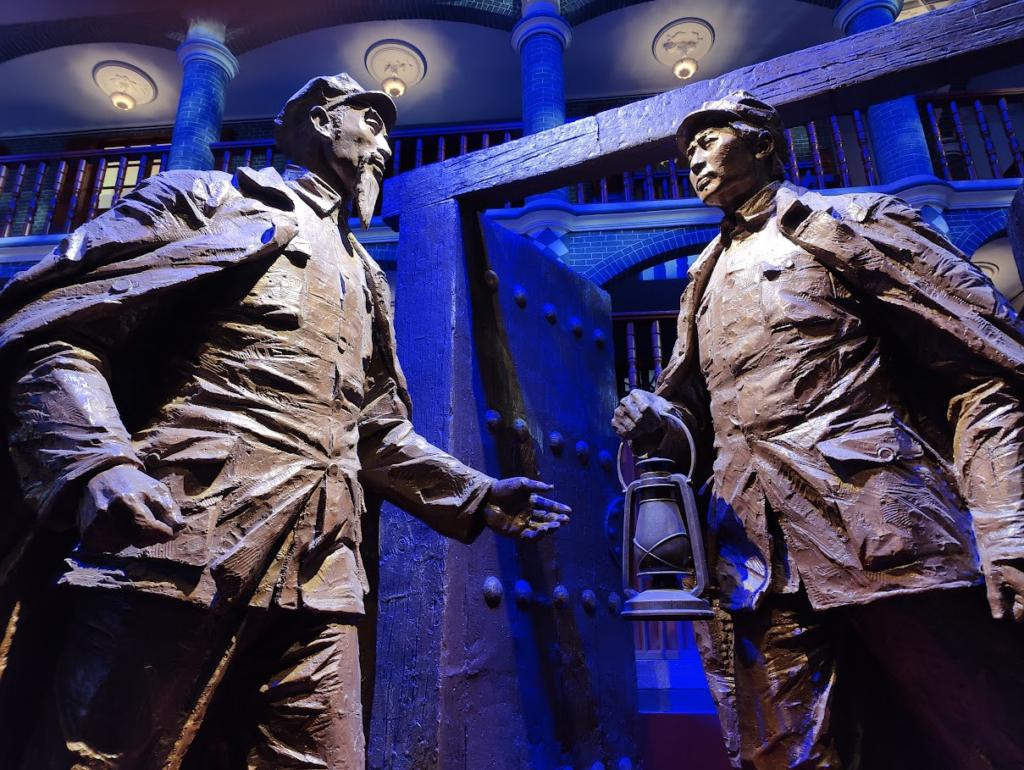
The delegation’s final item of official business was to attend the opening ceremony of the Third Dialogue on Exchanges and Mutual Learning Among Civilisations and the First World Conference of Sinologists, held at the China National Archives of Publications and Culture. Held under the auspices of the IDCPC, it was hosted by the Chinese Association for International Understanding (CAFIU). Chinese Vice President Han Zheng attended and addressed the opening session, where he also read a letter of greetings sent by President Xi Jinping. Other speakers in the opening session included former Spanish socialist Prime Minister José Luis Rodríguez Zapatero and party and state leaders from the Central African Republic, Mauritania and Malaysia.
All in all, it was a remarkable and inspiring trip, from which we learnt a great deal. From all of our visits and discussions, and from everything we witnessed, it is evident that the Chinese people are living better than ever, and are marching forward with confidence towards an even brighter future. We return with greater resolve than ever to tell the truth about China, to promote the successes of Chinese socialism, and to mobilise the broadest popular opposition to the New Cold War and the imperialist project of encircling and containing China.
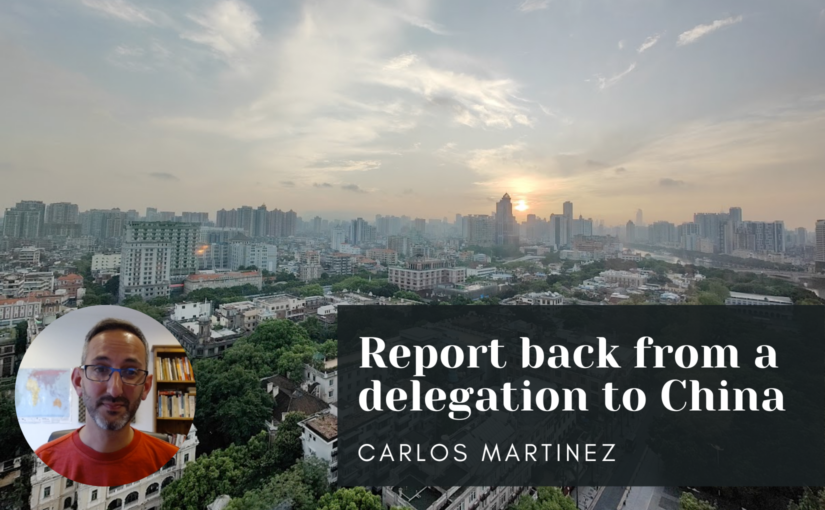

Wonderful optimistic report. Many thanks. While we have China, we have hope!